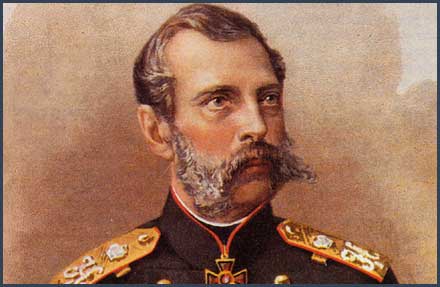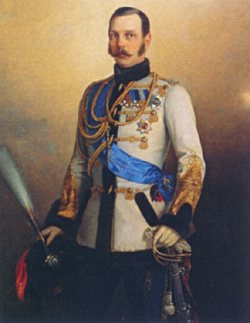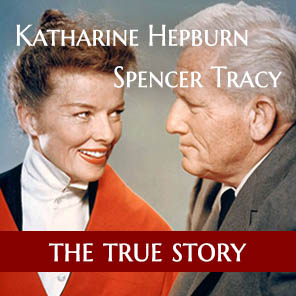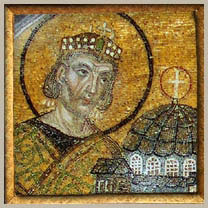Biographies - Alexander II
The Tsar Liberator - by Nick Nicolason


The reign of Alexander II is marked by contrasts; while Alexander II was known as the "Tsar-Liberator" for his emancipation of the Russian serfs, he also reigned over one of the most repressive periods in Russian history and faced numerous attempts on his life, ultimately resulting in his assassination. His personal life exhibited a similar dichotomy, as he was an unprecedented benefactor to children and orphans, yet humiliated his own wife and family by installing his mistress (and later morganatic wife) and their children in rooms in the Winter Palace above his family's own quarters.
The eldest son of Emperor Nicholas I, Alexander was born in Moscow on the 17th of April, 1818. Educated by legions of private tutors, Alexander also was forced to endure rigorous military training which his father felt was crucial to the development of strength and character. In 1841, he married a Hessian princess, who, after her conversion to Orthodoxy became known as Maria Alexandrovna.
After the death of his father, he ascended the throne on the 19th of February 1855, and was crowned in the Dormition Cathedral of the Moscow Kremlin on the 26th of August, 1856. Alexander II came to the throne in the midst of the Crimean War, a devastating military conflict for Russia, in which troops were decimated, and the shortcomings of the Russian military clearly evidenced. Late in 1856, Alexander signed the Treaty of Paris, which brought the ill-fated War to a swift conclusion.
After the end of the war, Alexander acknowledged that the serf-based economy would no longer support Russia's needs to compete with nations such as Britain and France. The landowning nobility objected to this idea, and were certain that the abolition of serfdom would undermine their primary sources of income. Though Alexander understood the devastating effects the abolition of serfdom would have on the fortunes of the rich, he is reported to have addressed a group of Moscow nobles by saying: "It is better to abolish serfdom from above than to wait for the time when it will begin to abolish itself from below."
In 1861 Alexander issued the "Emancipation Manifesto" which proposed 17 legislative acts that would abolish serfdom within the Russian Empire. Alexander announced that individual serfdom would be eliminated and all peasants would be allowed to purchase land from their landlords. The State would advance the money to the landlords and would then recover it from the peasants in 49 annual sums known as "redemption payments". This was deleterious to the finances of the state, and the land reforms proved damaging to the entire structure of the Russian Empire by creating deficits, and placing the peasant farmers at the mercy of cruel landlords and unreliable crop returns. In some regions it took peasants nearly 20 years to obtain their land. Many were forced to pay more than the land was worth and others were given inadequate amounts for their needs.
Alexander also introduced other reforms and in 1864 he allowed each district to set up a Zemstvo. These were local councils with powers to provide roads, schools and medical services. However, the right to elect members was restricted to the wealthy noble landowners.
Alexander II also implemented many important and original national reforms, including universal military service and municipal and legal reorganization.
He also reevaluated foreign policy: Russia reassessed its policy of continuous overseas expansion and concentrated on strengthening its own borders. In 1867, he sold Alaska and the Aleutian Islands to the United States, and used the proceeds to gild the domes of St. Isaac's Cathedral in St. Petersburg in thanks for the peace that the Russian Empire had begun to enjoy due to his reforms.
The most important foreign policy achievement of his reign was the successful war of 1877-8 against the Ottoman Empire, resulting in the liberation of Bulgaria and annulment of the conditions of the Treaty of Paris of 1856, imposed after Russia's defeat in the Crimean War.
Alexander's reforms generally did not satisfy liberals and radicals who wanted a parliamentary democracy and the freedom of expression that was enjoyed in the United States and some other European nations
Alexander displayed a marked passion for helping orphans and children, and made personal wards of many of the children orphaned by the Crimean and Ottoman Wars. One of these, Catherine Dolgorukaya, captured his particular attention. Princess Dolgoruky, a beautiful descendant of one of Russia's oldest families ultimately became the Emperor's mistress, and the children of this morganatic union carried the title Prince and Princess Yurievsky (after Prince Yuri Dolgoruky, Catherine's earliest ancestor).
Some dissidents preferred a policy of terrorism to obtain reform and on 14th April, 1879, Alexander Soloviev, a former schoolteacher, tried to kill Alexander. His attempt failed and he was executed the following month. The government responded to the assassination attempt by appointing six military governor-generals that imposed a rigorous system of censorship and repression in Russia.
The following month terrorists used nitroglycerine to attempt to destroy the Tsar's train. However, the terrorist miscalculated and it destroyed another train instead. An attempt the blow up the Kamenny Bridge in St. Petersburg as the Tsar was passing over it was also unsuccessful.
In 1880, Khalturin constructed a mine in the basement of the winter palace under a dining-room. The mine went off at half-past six at the time that the assassins had calculated Alexander would be having his dinner. However, his main guest, Prince Alexander of Battenburg, had arrived late and dinner was delayed and the dining-room was empty. Alexander was unharmed but sixty-seven people were killed or badly wounded by the explosion.
The fading health of the Empress and the constant threats on his own life forced Alexander II to think carefully about further reform and his personal future, and so, on 25th February, 1880, Alexander announced that he was considering granting the Russian people a constitution. To show his good will a number of political prisoners were released from prison. Loris Melikof, the Minister of the Interior, was given the task of devising a constitution that would satisfy the reformers but at the same time preserve the powers of the autocracy.
In January 1881, Loris Melikof presented his plans to Alexander. They included an expansion of the powers of the Zemstvo. Under his plan, each zemstov would also have the power to send delegates to a national assembly called the Gosudarstvenny Soviet that would have the power to initiate legislation. Alexander was concerned that the plan would give too much power to the national assembly and appointed a committee to look at the scheme in more detail.
On 1st March, 1881, Alexander was traveling in a closed carriage, from Mikhailovsky Palace to the Winter Palace in St. Petersburg. An armed Cossack sat with the coach-driver and another six Cossacks followed on horseback. Behind them came a group of police officers in sledges.
On a street corner near the Catherine Canal Sophia Perovskaya gave the signal to Nikolai Rysakov and Timofei Mikhailov to throw their bombs at the Tsar's carriage. The bombs missed the carriage and instead landed amongst the Cossacks. The Tsar was unhurt but insisted on getting out of the carriage to check the condition of the injured men. While he was standing with the wounded Cossacks another terrorist, Ignatei Grinevitski, threw his bomb. Alexander was killed instantly and the explosion was so great that Grinevitski also died from the bomb blast. The constitution was never to be granted.
On the site where he was killed, the Cathedral of the Resurrection on Blood was erected.
Please send your comments on this page to the author - Nick Nicholson





 Imperial Bedroom
Imperial Bedroom Portrait Hall
Portrait Hall Mauve Room
Mauve Room Maple Room
Maple Room Aleksey's Bedroom
Aleksey's Bedroom Nicholas's Study
Nicholas's Study Aleksey's Playroom
Aleksey's Playroom Formal Reception
Formal Reception Balcony View
Balcony View Aleksey- Balcony
Aleksey- Balcony Children-Mauve
Children-Mauve Nicholas's Bathroom
Nicholas's Bathroom Alexandra- Mauve
Alexandra- Mauve Nicholas's Reception
Nicholas's Reception Tsarskoe Selo Map
Tsarskoe Selo Map